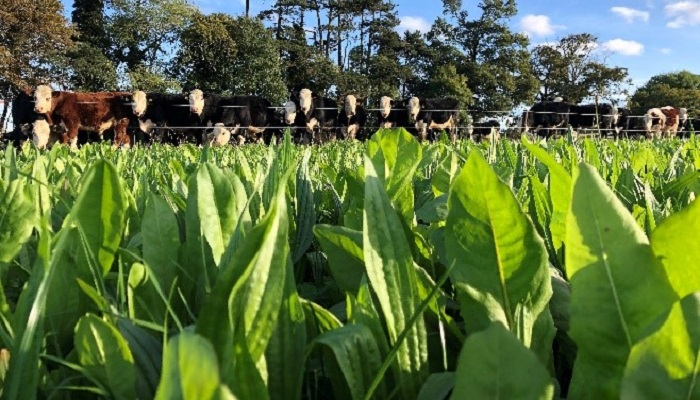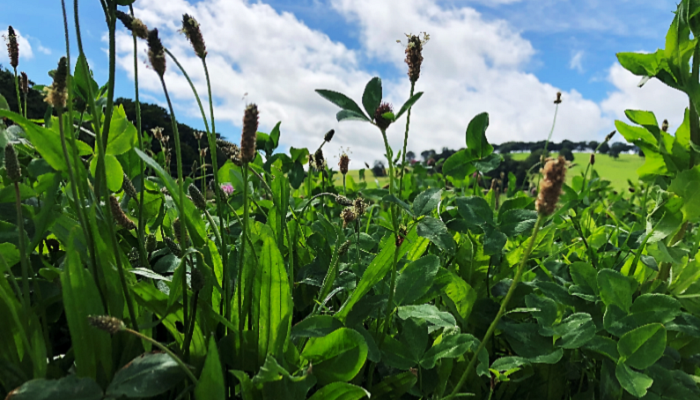01 March 2023
Seachtain na Gaeilge – Bainsí Ilspeiceas

An Dr Shona Baker, Taighdeoir Iardhochtúireachta ar an tionscadal multi4more
Tá córais beostoic bunaithe ar fhéar tábhachtach ó thaobh hinbhuanaitheacht táirgeadh beostoic de. Mar sin féin, le blianta beaga anuas tá feabhas tagtha ar thalamh féaraigh talmhaíochta i réigiúin mheasartha dírithe ar shimpliú agus aonchineálú féarach, rud a d’fhág go rabhthas ag brath níos mó ar mhonashaothrú seagalach ilbhliantúil (perennial ryegrass) mar gheall ar a tháirgiúlacht agus a iontaofacht. Feictear go mbraitheann seagalach ilbhliantúil go mór, áfach, ar ionchur ard nítrigine.
Tugann a leithéid de spleáchas ar leasachán nítrigine dúshlán d’inbhuanaitheacht na gcóras a thagann as sin; is ionann é agus costas díreach suntasach d’fheirmeoirí, agus méadaíonn sé an baol caillteanais don timpeallacht máguaird nuair is féidir go gcaillfí bithéagsúlacht, go bhfeicfeá truailliú uisce, ardú ar astuithe gáis cheaptha teasa agus truailliú aeir dá bharr. Tá sé ríthábhachtach spleáchas ar agra-cheimiceáin a laghdú chun córais táirgthe níos inbhuanaithe a fhorbairt agus mar sin tá sé ríthábhachtach roinnt de na Spriocanna Forbartha Inbhuanaithe a leagtar amach i gClár Forbartha na Náisiún Aontaithe a bhaint amach.
Tríd léagúim a chur in áireamh i bhféarach, laghdófar an gá le leasacháin nítrigine agus is féidir go dtiocfaidh feabhas ar tháirgeadh foráiste, cosc fiailí, soláthar gnáthóige do phailneoirí, méadú ar ghníomhaíocht péisteanna talún agus rátaí insíothlaithe uisce ithreach gaolmhar, agus luach cothaithe féaraigh feabhsaithe i gcoibhneas le monashaothrú seagalach ilbhliantúil. Fuarthas go raibh tairbhe ag baint le héagsúlacht mhéadaithe féaraigh chuig bainsí ilspeiceas ina bhfuil trí ghrúpa feidhme plandaí (féar, léagúim agus luibheanna foráiste) ó thaobh táirgeacht ard foráiste a choinneáil agus I bhfad níos lú leasacháin nítrigine in úsáid, i gcomparáid le monashaothrú seagalach ilbhliantúil. Is as éagsúlacht ó thaobh an feidhmghrúpa de a dtagann an táirgiúlacht mhéadaithe, rud a dtéann i léig théis 4-8 spéiceas ina iomlán a shroicint.

Feictear go gcuireann bainsí ilspeiceas feabhas ar shláinte agus ar fheidhmíocht ainmhithe innilte .i. níos lú gá le frith-heilmintigh ceimiceacha, agus méadú ar mheáchan beo agus scór riocht coirp na n-uan féarach. Feictear freisin go bhféadfadh sé cur le micrea-mhianraí agus macra-mhianraí breise ar fáil do bheostoc mar gheall ar aiste bia níos éagsúla. Tacaíonn bainsí ilspeiceas le níos mó éagsúlacht i measc feithidí ná féar le seamair agus d’fhéadfadh sé astuithe gáis cheaptha teasa a laghdú. Fuarthas amach freisin go bhfeabhsaíonn siad lamháltas triomach, struchtúr na hithreach, agus gur féidir leis porosacht na hithreach a mhéadú i gcomparáid le monashaothraithe féir.
D’fhéadfadh torthaí den sórt sin a bheith mar thoradh ar úsáid chomhlántach acmhainní agus ar éascú, tacaithe ag straitéisí fáis éagsúla á ghlacadh ag fiedhmghrúpaí éagsúla, nó ag speiceas aonair .
Déanfaidh tionscadal nua dar teideal Multi4More imscrúdú agus feabhas a chur ar ár dtuiscint d’éagsúlacht plandaí agus ar éifeachtaí leasacháin ar bainsí ilspeiceas chun feidhmíocht agranamaíoch, agus inbhuanaitheacht comhshaoil a fheabhsú i gcórais beostoic foráiste-bhunaithe faoi choinníollacha nítrigine níos ísle, agus forbróidh sé acmhainní aistrithe eolais spriocdhírithe.
Dhá phríomhcheist a bhfuil sé d’aidhm ag an tionscadal a fhreagairt ná:
- Cad é an cóimheas is fearr ar fhéar:léagúim:luibh i meascáin ilspeiceas le haghaidh foráiste agus táirgeadh beostoic?
- Céard é an méad is lú nítrigine gur féidir a úsáid gan cur isteach ar tháirgeacht agus ar cháilíocht?
Multispecies swards
Dr. Shona Baker, Postdoctoral Researcher on the multi4more project
Grass-based livestock systems are important for the sustainability of livestock production. However, in recent years there has been an improvement in agricultural grassland in temperate regions aimed at simplifying and homogenizing pastures, which has resulted in a greater reliance on perennial ryegrass monocultures. However, perennial ryegrass is highly dependent on high nitrogen input.
Such dependence on nitrogen fertiliser challenges the sustainability of the resulting systems in that; it represents a significant direct cost to farmers and increases the risk of loss to the surrounding environment where it can result in loss of biodiversity, water pollution, elevated greenhouse gas emissions and air pollution. Reducing reliance on agro-chemicals is therefore fundamental to the development of more sustainable production systems and is key to achieving a number of the Sustainable Development Goals set out by the United Nations Development Programme
Including legumes in pastures reduces the need for nitrogen fertilisers and can lead to improved forage production, weed control, habitat provision for pollinators, increased earthworm activity and associated soil water infiltration rates, and improved pasture nutritional value relative to monocultures of perennial ryegrass. Multispecies swards containing three plant functional groups (grasses, legumes and forage herbs) has been found to be beneficial in maintaining high forage yields using significantly less nitrogen fertiliser, compared to perennial ryegrass monocultures. This increased productivity comes from functional group diversity which peaks at 4-8 species.
Multispecies swards have been shown to improve the health and performance of grazing animals i.e. reduced need for anthelmintics, increased live weight and body condition score of lambs and potentially contributing additional micro and macro minerals to livestock due to a more varied diet. These swards have been shown to support greater insect diversity than grass-clover swards and may reduce greenhouse gas emissions. It has also been found that multispecies swards improve drought tolerance, soil structure, and can increase soil porosity compared to grass monocultures. Such results could be the result of complementary use of resources and facilitation, supported by different growth strategies adopted by different functional groups, or by individual species.
A new project called Multi4More will investigate and improve our understanding of plant diversity and fertiliser effects on multispecies swards to improve agronomic performance, and environmental sustainability in forage-based livestock systems under lower nitrogen conditions, and will develop resources targeted knowledge transfer.
Two main questions that the project aims to answer are:
- What is the optimum ratio of grass:legume:herb in multispecies mixtures for forage and livestock production?
- What is the least amount of nitrogen that can be used without affecting yield and quality?
